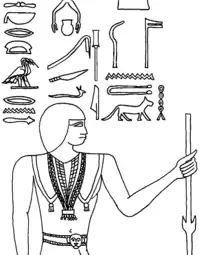| Khabawsokar in hieroglyphs | ||||
|---|---|---|---|---|
Name: Khabawsokar ḫʳ-b3w-skr The souls of Sokar ashine | ||||
Honorary title: Rekh-neswt rḫ-nsw.t Confidant of the king | ||||
 | ||||
Khabawsokar (also read Khabawseker) was an Ancient Egyptian high official during the early to midst 3rd dynasty. He is famous for his tomb inscription and his unique nickname.[1]
Identity
Family
Khabawsokar was married to the priestess of Hathor, Hathor-neferhetepes.[1][2]
Titles
As a high-ranking official and priest, Khabawsokar bore several elite and pious titularies:[2]
- Confidant of the king (Egyptian: Rekh-neswt). A title that allowed Khabawsokar to receive audiences with the pharaoh.[3]
- Privy councilor (Egyptian: Sa'ab).
- High priest of Anubis (Egyptian: Heqa-netjer-Inpu).
- God's servant of Sokar (Egyptian: Hem-netjer-Seker).
- God's servant of Seshat (Egyptian: Hem-netjer-Seshat).
- God's servant of Seth (Egyptian: Hem-netjer-Setekh).
Career
Khabawsokar's tomb inscriptions are of the highest interest to Egyptologists and historians alike. In fact, they belong to the earliest examples of richly decorated tomb niches with detailed lists comprising bureaucratic titles, priestly offices and honorary titles.[1][2] Additionally, Khabawsokar is, by far, the official with the highest number of priesthood titles for his time.[4]
In his tomb, Khabawsokar is depicted once as a sitting man in a tight gown, reaching out for an offering table full of bread (or cake). A jamb of a false door depicts him twice, each time looking into converse directions. His pose makes him look like he is stepping out of the door. On both of the jambs his real ("great") name and his nickname are spelled. Khabawsokar wears a fine curled wig, a heavy and finely ornamented gold collar and a belt with a golden lion head as a belt buckle. His kilt is made of leopard fur and his shoulder knots are jackal-shaped.[1][2]
Possible contemporary office partners of Khabawsokar may have been Hesyre, Metjen, Pehernefer and Akhetaa. These are likewise known for their unusually rich decorated tomb chapels and for their accurately reported careers. However, it is not proven that these officials were related to each other in any way.[1][2]
Tomb
Khabawsokar's tomb, the double mastaba S-3037, was found in 1889 at North Saqqara by French archaeologist Auguste Mariette. The tomb once measured circa 33 x 19 metres and was built of mud bricks. A short corridor leads to a broad hall, forming a t-shaped crossway; the hall has walls which are niched and covered with polished limestone.[1][2]
References
- 1 2 3 4 5 6 Peter Jánosi: Die Gräberwelt der Pyramidenzeit (= Zaberns Bildbände zur Archäologie-series). von Zabern, Mainz 2006, ISBN 3805336225, p. 16, 31 - 33.
- 1 2 3 4 5 6 William Stevenson Smith, William Kelly Simpson: The art and architecture of ancient Egypt (= The Pelican history of art, vol. 14), 2nd edition. Penguin Books, New York 1981, ISBN 0-14-056014-9, p. 63–67.
- ↑ Dilwyn Jones: An Index of Ancient Egyptian Titles, Epithets and Phrases of the Old Kingdom, Vol. 1 (= BAR International Series, vol. 866). Archaeopress, Oxford 2000, ISBN 1-8417-1069-5, p. 357, Nr. 1325.
- ↑ Dagmar Budde: Die Göttin Seschat. Wodtke und Stegbauer, Leipzig 2000, ISBN 3934374018, p. 66-70.